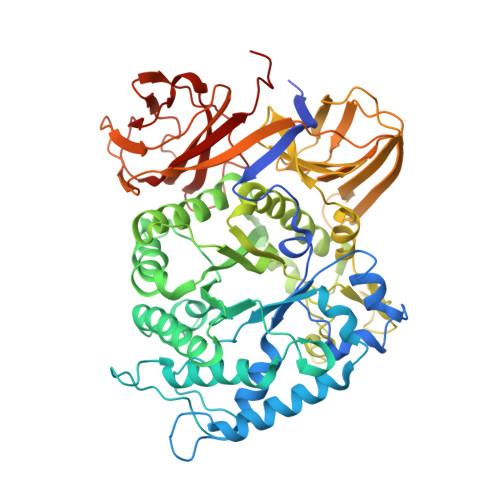Molecular basis of an agarose metabolic pathway acquired by a human intestinal symbiont.
Pluvinage, B., Grondin, J.M., Amundsen, C., Klassen, L., Moote, P.E., Xiao, Y., Thomas, D., Pudlo, N.A., Anele, A., Martens, E.C., Inglis, G.D., Uwiera, R.E.R., Boraston, A.B., Abbott, D.W.(2018) Nat Commun 9: 1043-1043
- PubMed: 29535379
- DOI: https://doi.org/10.1038/s41467-018-03366-x
- Primary Citation of Related Structures:
5T98, 5T99, 5T9A, 5T9G, 5T9X, 5TA0, 5TA1, 5TA5, 5TA7, 5TA9 - PubMed Abstract:
In red algae, the most abundant principal cell wall polysaccharides are mixed galactan agars, of which agarose is a common component. While bioconversion of agarose is predominantly catalyzed by bacteria that live in the oceans, agarases have been discovered in microorganisms that inhabit diverse terrestrial ecosystems, including human intestines. Here we comprehensively define the structure-function relationship of the agarolytic pathway from the human intestinal bacterium Bacteroides uniformis (Bu) NP1. Using recombinant agarases from Bu NP1 to completely depolymerize agarose, we demonstrate that a non-agarolytic Bu strain can grow on GAL released from agarose. This relationship underscores that rare nutrient utilization by intestinal bacteria is facilitated by the acquisition of highly specific enzymes that unlock inaccessible carbohydrate resources contained within unusual polysaccharides. Intriguingly, the agarolytic pathway is differentially distributed throughout geographically distinct human microbiomes, reflecting a complex historical context for agarose consumption by human beings.
Organizational Affiliation:
Department of Biochemistry and Microbiology, University of Victoria, PO Box 3055 STN CSC, Victoria, BC, V8W 3P6, Canada.

















